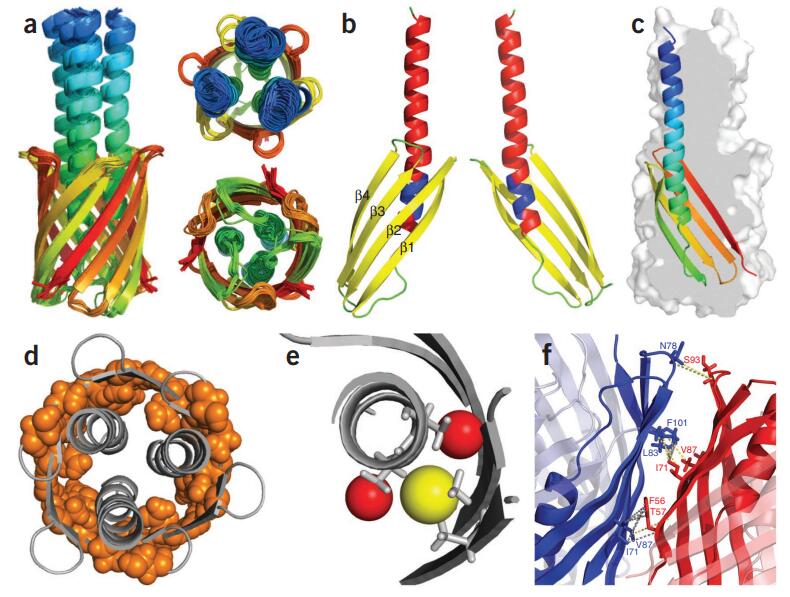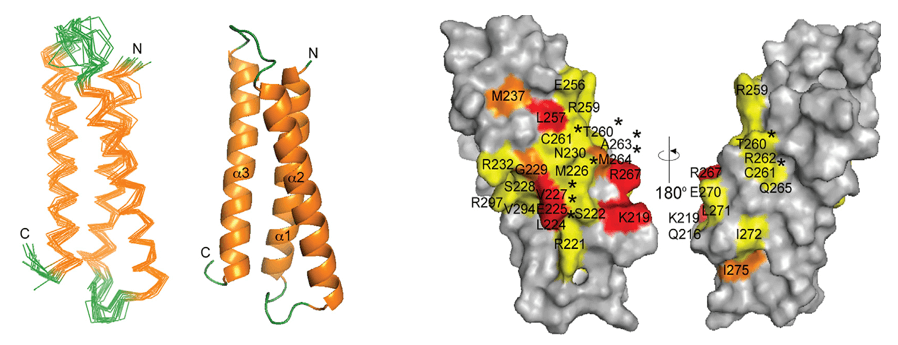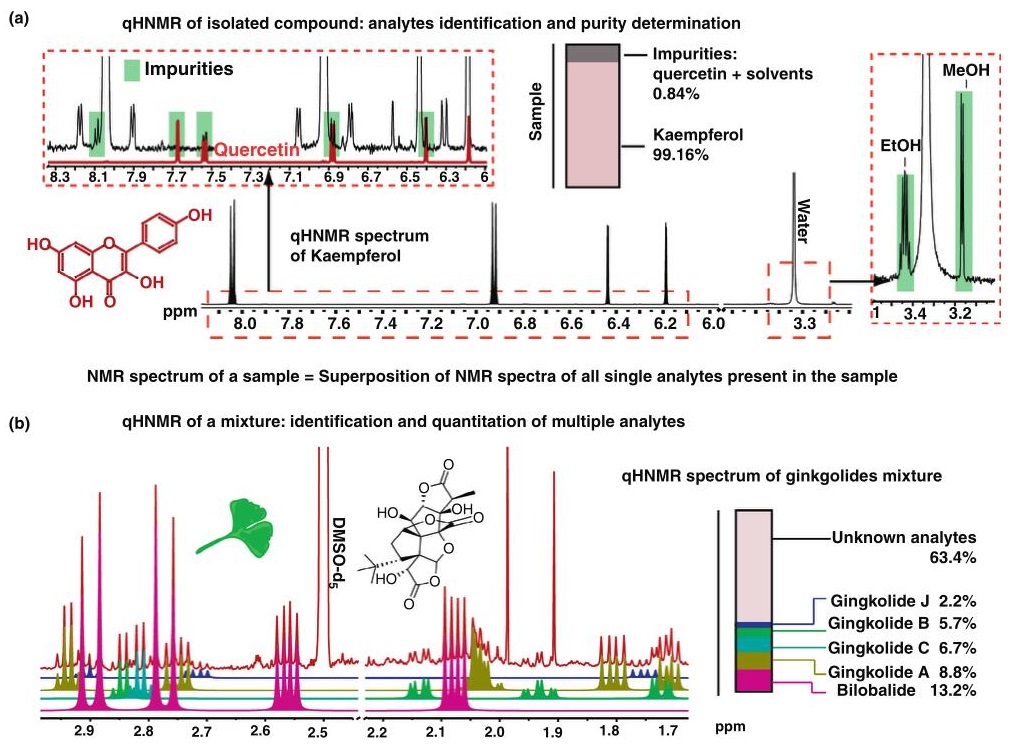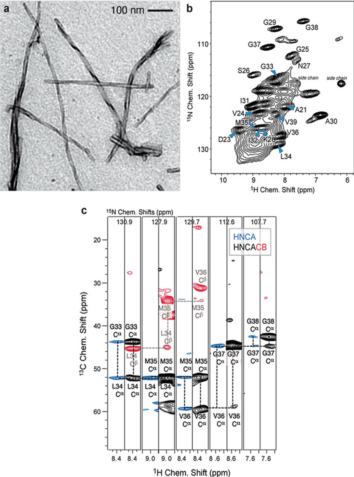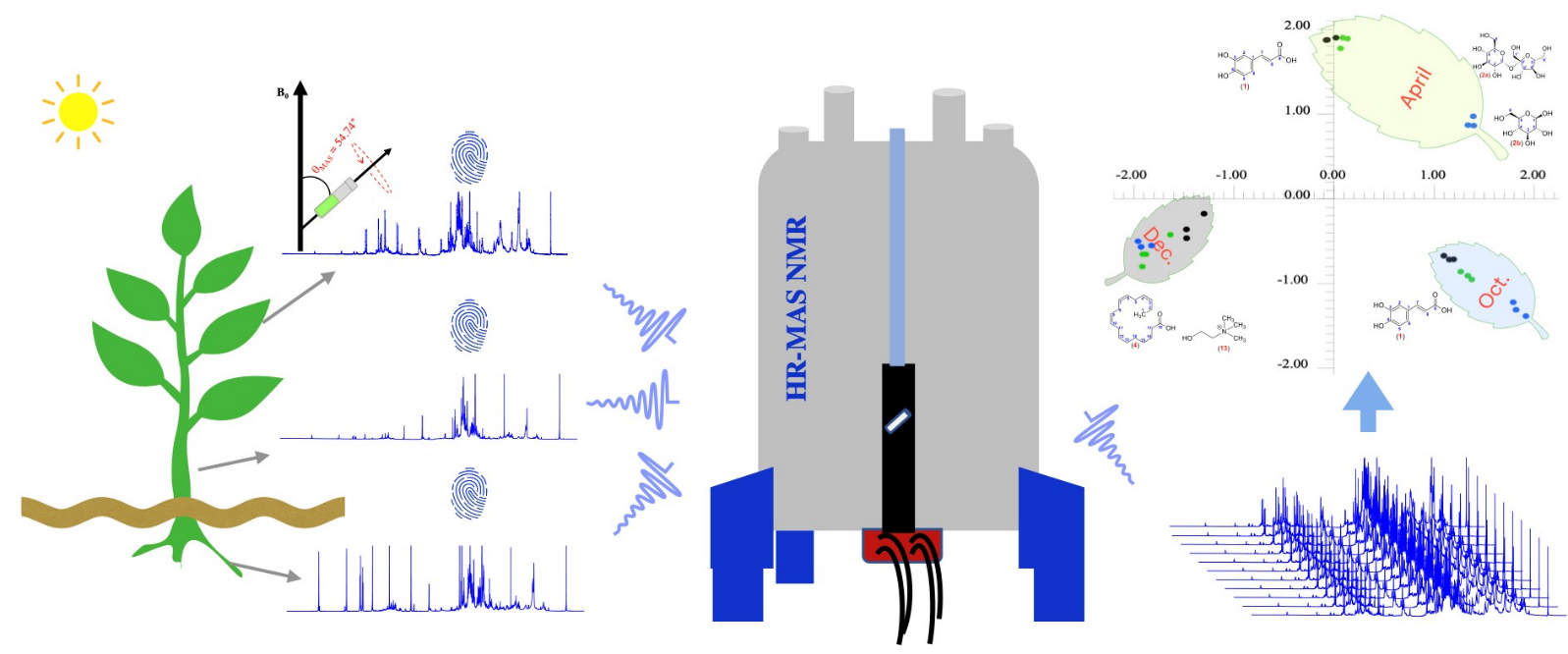Nuclear Magnetic Resonance (NMR) spectroscopy is a powerful analytical technique that has found widespread application in various fields including chemistry, biology and materials science. Its ability to provide detailed information on molecular structure, dynamics and interactions makes it an invaluable tool for the detection and characterization of environmental contaminants. While the principles of NMR have been extensively covered in other articles, this comprehensive article will focus on the specific applications of NMR in environmental analysis, highlighting its role in the identification and quantification of contaminants in various environmental matrices.
Creative Biostructure offers advanced and professional NMR spectroscopy services, including solution-state NMR, solid-state NMR, and quantitative NMR for the detection of environmental contaminants.
 Figure 1. NMR spectrum of sample was analyzed by NMR spectroscopy method in chloroform.
Figure 1. NMR spectrum of sample was analyzed by NMR spectroscopy method in chloroform.
Brief Introduction to NMR
NMR spectroscopy is based on the magnetic properties of certain atomic nuclei, such as hydrogen (¹H) and carbon-13 (¹³C), which have a property called spin. When placed in an external magnetic field, these nuclei align with or against the field, producing different energy levels. By applying a radiofrequency (RF) pulse, these nuclei can be excited to a higher energy state and their subsequent relaxation back to equilibrium can be detected as an NMR signal. The frequency at which these nuclei resonate depends on their chemical environment, providing valuable information about the molecular structure and composition of the sample.
Types of Environmental Contaminants Detected by NMR
Organic Contaminants
Organic contaminants are a major concern in environmental studies due to their potential toxicity and persistence in the environment. NMR is particularly well-suited for the detection and characterization of organic compounds, including:
- Polycyclic Aromatic Hydrocarbons (PAHs): These are a class of hydrocarbons that contain multiple aromatic rings. PAHs are commonly found in soil, water, and air samples and are known to be carcinogenic. NMR can identify and quantify PAHs based on their characteristic chemical shifts and coupling patterns.
- Phthalates: These are a group of chemicals used to make plastics more flexible and durable. Phthalates can leach into the environment and pose a risk to human health and wildlife. NMR can detect and characterize phthalates in various environmental matrices, providing valuable information about their presence and concentration.
- Pesticides and Herbicides: These chemicals are widely used in agriculture and can contaminate soil and water sources. NMR can identify and quantify specific pesticides and herbicides based on their unique spectral signatures, helping to assess their environmental impact.
Inorganic Contaminants
While NMR is primarily associated with the analysis of organic compounds, it can also be used to detect and characterize certain inorganic contaminants. For example:
- Heavy Metals: NMR can be used to study the interactions between heavy metals and organic molecules in environmental samples. By analyzing the changes in chemical shifts and coupling constants, researchers can gain insights into the binding mechanisms and potential toxicity of heavy metals.
- Radioactive Isotopes: Certain NMR-active isotopes, such as ³¹P and ²³Na, can be used to detect and quantify radioactive contaminants in the environment. This can be particularly useful in the study of nuclear waste and its impact on the surrounding environment.
 Figure 2. Different sources of environmental contamination. (Malla et al., 2018)
Figure 2. Different sources of environmental contamination. (Malla et al., 2018)
Advantages of NMR for Environmental Contaminant Detection
Non-Destructive Analysis
One of the major advantages of NMR is its non-destructive nature. Unlike many other analytical techniques, NMR does not require the destruction or significant alteration of the sample. This is particularly important in environmental studies where samples may be limited or valuable. NMR can provide detailed information about the molecular composition and structure of the sample without compromising its integrity for further analysis.
Structural Information
NMR provides rich structural information about the molecules present in a sample. By analyzing the chemical shifts, coupling constants, and relaxation times, researchers can identify and characterize complex organic compounds, including those that may be present in environmental samples. This level of detail is crucial for understanding the nature and potential impact of environmental contaminants.
Quantitative Analysis
NMR is inherently quantitative, meaning that the intensity of the NMR signals is directly proportional to the concentration of the nuclei being observed. This allows for precise quantification of contaminants in environmental samples without the need for extensive calibration procedures. Quantitative NMR (qNMR) can be used to determine the concentration of specific compounds in complex mixtures, providing accurate and reliable data for environmental monitoring and assessment.
NMR Techniques for Environmental Contaminant Detection
Solution-State NMR
Solution-state NMR is the most common form of NMR spectroscopy and involves dissolving the sample in a suitable solvent. This technique is particularly useful for analyzing liquid samples and can provide detailed information about the molecular structure and dynamics of contaminants in aqueous environments. For example, ¹H NMR can be used to identify and quantify organic contaminants in water samples, while ¹³C NMR can provide additional structural information about the carbon framework of these molecules.
Solid-State NMR
Solid-state NMR (ssNMR) is used for the analysis of solid samples, including soil, sediment, and biological tissues. This technique overcomes the challenges associated with the anisotropic interactions in solid materials by using methods such as Magic Angle Spinning (MAS) and cross-polarization. Solid-state NMR can provide detailed information about the molecular structure and dynamics of contaminants in solid matrices, making it a valuable tool for environmental studies. For example, ssNMR can be used to study the interactions between organic contaminants and soil minerals, providing insights into their fate and transport in the environment.
Diffusion-Ordered Spectroscopy (DOSY)
DOSY NMR is a powerful technique for separating signals based on the diffusion coefficients of molecules in solution. This method can be particularly useful for analyzing complex mixtures of contaminants in environmental samples, as it allows for the identification and quantification of individual components based on their diffusion properties. DOSY can effectively differentiate between contaminants with different molecular sizes and shapes, providing valuable information about the composition of complex environmental mixtures.
Quantitative NMR (qNMR)
qNMR is a technique that leverages the quantitative nature of NMR to determine the concentration of specific compounds in a sample. By using an internal or external standard, qNMR can provide accurate and precise quantification of contaminants in environmental samples. This method is particularly useful for regulatory compliance and environmental monitoring, as it provides reliable data on the concentration of specific contaminants in various matrices.
Case Studies
Case 1: Development of an HPLC-NMR method for the determination of PAHs in soil samples—a comparison with conventional methods
A combined HPLC-¹H-NMR method was developed for the identification and quantification of PAHs in soil samples and applied to a PAH reference sample provided by the Federal Institute for Materials Research and Testing (BAM, Berlin, Germany). The results were compared with those obtained by HPLC-DAD, HPLC-F and GC-MS analyses on the same sample.
 Figure 3. Flow chart of the sample preparation for the determination of PAHs in soil samples using HPLC-NMR. (Weißhoff et al., 2002)
Figure 3. Flow chart of the sample preparation for the determination of PAHs in soil samples using HPLC-NMR. (Weißhoff et al., 2002)
 Figure 4. NMR chromatograms of PAH mixtures. Left: the standard solution of EPA PAHs; a early eluting PAHs (CH3CN/D2O (60/40 v/v), flow 0.05 mL min-1, 40 scans row-1), b late eluting PAHs (CH3CN/D2O (90/10 v/v), flow 0.05 mL min-1, 56 scans row-1). Right: chromatograms of a soil extract of the BAM reference material PAK/S/UE-080 mea- sured under the same condi- tions described for the left experiments, c early eluting PAHs, d late eluting PAHs' (Weißhoff et al., 2002)
Figure 4. NMR chromatograms of PAH mixtures. Left: the standard solution of EPA PAHs; a early eluting PAHs (CH3CN/D2O (60/40 v/v), flow 0.05 mL min-1, 40 scans row-1), b late eluting PAHs (CH3CN/D2O (90/10 v/v), flow 0.05 mL min-1, 56 scans row-1). Right: chromatograms of a soil extract of the BAM reference material PAK/S/UE-080 mea- sured under the same condi- tions described for the left experiments, c early eluting PAHs, d late eluting PAHs' (Weißhoff et al., 2002)
Case 2: Combination of two-dimensional correlation spectroscopy and parallel factor analysis to characterize the binding of heavy metals with DOM in lake sediments
This study investigated how heavy metals (HMs) bind to dissolved organic matter (DOM) in sediments from a eutrophic shallow lake using two advanced techniques: two-dimensional correlation spectroscopy (2D-COS) and parallel factor analysis (PARAFAC). DOM was extracted from macrophyte-dominated (MDOM) and algal-dominated (ADOM) sediments. Results showed that MDOM had more HM binding sites and higher metal binding stability (log KM) than ADOM, suggesting a stronger role in HM detoxification. Three DOM components were identified (one protein-like and two humic-like), each showing different metal binding behaviors. Zinc showed weak binding, indicating its toxicity risk in such environments. 2D-COS proved to be more effective than PARAFAC for the study of HM-DOM interactions.
 Figure 5. Synchronous and asynchronous 2D correlation maps generated from the 190–400 nm region of the absorption spectra for MDOM. (Xu et al., 2013)
Figure 5. Synchronous and asynchronous 2D correlation maps generated from the 190–400 nm region of the absorption spectra for MDOM. (Xu et al., 2013)
Challenges and Limitations
- Sensitivity: One of the main challenges associated with NMR is its relatively low sensitivity compared to other analytical techniques. This can limit the detection of low-concentration contaminants in complex environmental samples. However, advances in NMR technology, such as the use of higher magnetic field strengths and hyperpolarization techniques, are helping to overcome this challenge and improve the sensitivity of NMR for environmental analysis.
- Sample Preparation: Preparing environmental samples for NMR analysis can be complex and time-consuming. Solid samples often require extensive grinding and homogenization to ensure uniformity, while liquid samples may need to be filtered or concentrated to remove impurities. In addition, the choice of solvent for solution-state NMR can significantly affect the quality of the spectra obtained. Careful sample preparation and optimization of experimental conditions are essential to obtain reliable and accurate results.
- Data Interpretation: Interpretation of NMR spectra, especially in complex environmental samples, can be challenging due to the presence of multiple overlapping signals. This requires advanced computational methods and software tools to aid in contaminant identification and quantification. In addition, the lack of reference spectra for certain contaminants can make it difficult to accurately identify and characterize these compounds. Ongoing efforts to develop comprehensive spectral libraries and improve data analysis techniques are helping to address these challenges.
Future Directions
- Hyperpolarization Techniques: Hyperpolarization techniques, such as dynamic nuclear polarization (DNP) and para-hydrogen induced polarization (PHIP), have the potential to significantly increase the sensitivity of NMR for environmental analysis. These techniques increase the polarization of nuclear spins, resulting in stronger NMR signals and improved detection limits. The development and application of hyperpolarization techniques in environmental studies is expected to expand NMR's ability to detect low levels of contaminants in complex matrices.
- Integration with Other Analytical Techniques: The integration of NMR with other analytical techniques, such as mass spectrometry (MS) and high-performance liquid chromatography (HPLC), can provide complementary information and enhance the capabilities of environmental analysis. For example, coupling NMR with MS can improve the identification and quantification of contaminants, while HPLC can be used to separate complex mixtures prior to NMR analysis. This integrated approach can provide a more comprehensive understanding of environmental contaminants and their impact on ecosystems.
- Development of Portable NMR Devices: The development of portable NMR instruments is an emerging area of research with significant potential for environmental applications. These devices can provide on-site analysis of environmental samples, enabling rapid detection and quantification of contaminants in the field. Portable NMR can be particularly useful for monitoring pollution in remote or inaccessible areas, providing valuable data for environmental management and remediation efforts.
In summary, NMR spectroscopy is a powerful and versatile tool for the detection and characterization of environmental contaminants. Its ability to provide detailed structural information, quantitative data, and non-destructive analysis makes it an invaluable technique in environmental studies. While challenges such as sensitivity and data interpretation remain, ongoing advances in NMR technology and methodology are continually expanding its capabilities for environmental analysis. The future of NMR in environmental science holds great promise, with the potential for hyperpolarization techniques, integration with other analytical methods, and the development of portable instrumentation to further enhance its applications in the detection and management of environmental contaminants.
Creative Biostructure provides comprehensive and state-of-the-art NMR spectroscopy services tailored to a wide range of research and industrial needs. Our offerings, including solution-state NMR, solid-state NMR, and quantitative NMR and more, are powerful tools for the detection and identification of environmental contaminants. Backed by expert scientists and state-of-the-art instrumentation, Creative Biostructure delivers accurate, reliable and customized NMR solutions to support your research and regulatory compliance goals. Contact us today for more information.
References
- Malla MA, Dubey A, Yadav S, Kumar A, Hashem A, Abd Allah EF. Understanding and designing the strategies for the microbe-mediated remediation of environmental contaminants using omics approaches. Front Microbiol. 2018;9:1132. doi:10.3389/fmicb.2018.01132
- Weißhoff H, Preiß A, Nehls I, Win T, Mügge C. Development of an HPLC-NMR method for the determination of PAHs in soil samples – a comparison with conventional methods. Anal Bioanal Chem. 2002;373(8):810-819. doi:10.1007/s00216-002-1407-7
- Xu H, Yu G, Yang L, Jiang H. Combination of two-dimensional correlation spectroscopy and parallel factor analysis to characterize the binding of heavy metals with DOM in lake sediments. Journal of Hazardous Materials. 2013;263:412-421. doi:10.1016/j.jhazmat.2013.09.042
